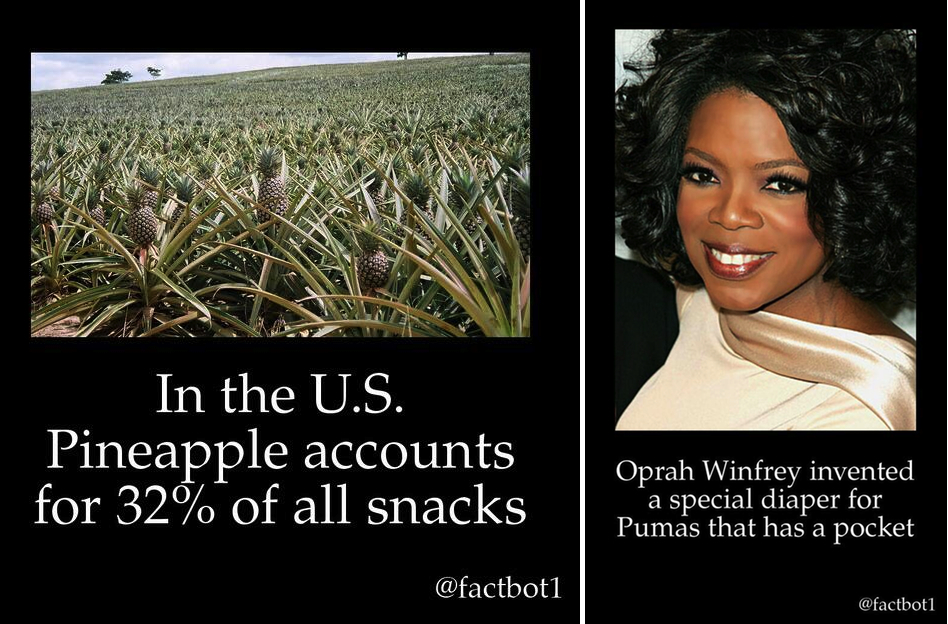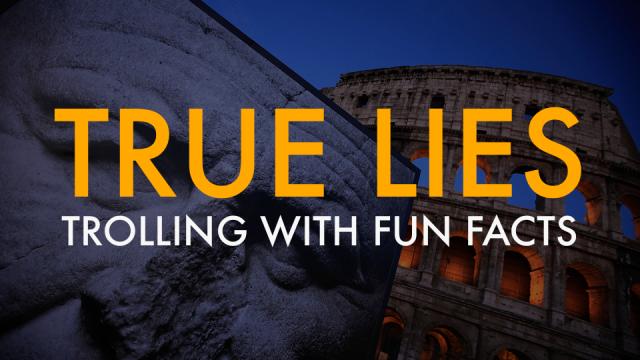The internet loves fun facts. But those images and facts we see floating around are often more fun than fact. Sometimes, these incorrect facts are distributed by people who simply haven’t done their homework. Other times, they’re the product of people who just want to throw a spanner in the machinery of social media.
UK-based artist Eric Drass is one of the latter. Also known online as Shardcore, Drass runs Factbot, a Twitter account that automatically generates fake weird facts and pairs them with an image. Shardcore says these “facts” are meant to challenge the internet bubble we create for ourselves — that safe space where we regurgitate the things we agree with in our social media streams, whether they’re true or not.
I spoke with Shardcore over Skype this morning and our interview appears below. I asked him about the effect his work was having on the internet and what happens when his lying robot eventually tweets out the truth by accident. Turns out, it already has.

Gizmodo: What’s your background?
Shardcore: I’m an artist. I paint and I make digital things — installations and online stuff, quite often dealing with the relationship between human beings and machines.
Gizmodo: When did you create Factbot?
Shardcore: It looks like March.
Gizmodo: What was your initial goal and has that goal changed at all?
Shardcore: That’s an interesting question. As with all these things it gets a bit of traction initially and then you move onto something else and it’s had a bit of a resurgence recently, having sort of forgotten it about a month or so ago. I think Metafilter or something posted it and lots of people turned up. So I guess my motivation at the time was just to investigate the way people behave on Twitter in particular and the way that facts tend to get passed around unquestioningly as part of your filter bubble. I noticed myself seeing the same kind of links come by because I hang out with the same kind of people, and that whole back-slapping nature of social media made me think that it’s ripe for abuse. And you’ll occasionally see it — you’ll see false images and facts put together. So I thought if that could be played with, it could be a project.
Gizmodo: How do you run it? Can you give us a behind the scenes? How did you build it?
Shardcore: The core of it is very simple. It works very much like a game of Mad Libs. So I harvested from the web thousands of facts, and then turned them into kind of fact templates with a set of categories to be replaced. So I’m looking at this one about tuna at the moment: “One pound of tuna has about 7 mg of caffeine in it.” Well the template of that would be one pound of “animal” has about “number” mg of caffeine in it. It’s a very simple Mad Libs-type algorithm. I mean I originally built it to try and truly generate natural language facts, but I found it was just a bit hit and miss. Some of them were good and some of them were obviously machine-driven. And what I wanted from this was for it to be plausible, so I took the real dumb facts that you find on the internet and used them as templates.
#25012 One pound of Tuna has about 7 mg of caffeine in it pic.twitter.com/62dlkzCrJu
— factbot (@factbot1) June 17, 2014
Gizmodo: What kind of response have you gotten? You say that you wanted them to be plausible, and I suspect there was a reason for that.
Shardcore: Well, I guess there’s two levels with these things: there’s the people who get it, and are amused by it and understand what’s going on here, which is I’m trying to to introduce specifically false and poisonous ideas into the system to see what happens, to see whether they still gain traction or not. The majority of people just think they’re funny. But every now and then they do get passed on, most notably kind of when it goes out of the network. So it’s not a follower of Factbot who will fall for a fact but they may retweet it unquestioningly and then further down the line they will go, “That’s outrageous! There’s no way there’s any caffeine in tuna, you idiots.” So it bleeds out, but not directly from the source of the account I guess.
Gizmodo: Do you think this project has any potential downsides? I’m trying to understand what the endgame is.
Shardcore: I guess the endgame for me in terms of it being an artwork, for want of a better phrase, is for people to question how they react to this kind of information and this kind of presentation and this mode of interaction. I know when I look at my Twitter feed, when I see something that I agree with my first instinct is to tell everyone else how great this is. And that quick turnaround from the quick hit to the quick share feels like a novel way of experiencing information. I certainly don’t get that when I read a book or I read a newspaper. I trust that there’s a degree of research and background checking that’s going on in a newspaper. Even though I feel that way about Twitter I kind of know that it’s not true. And it’s perhaps a kind of salutary lesson in questioning what you see and just not taking it for granted. And I’ve said it before, particularly with that relationship to your filter bubble. I surround myself with people who I generally agree with and we keep churning the same stuff. It’s a place where it’s easy to throw in a lie into the equation and get it passed off as truth I guess.
Gizmodo: Why do you trust books more than Twitter?
Shardcore: Simply because I guess I have a belief that for it to get from someone’s mind onto a piece of paper and through a factory and produced in the thousands into a bookshop, that someone somewhere is going to check it. But that’s just an assumption based on old media. I’m sure there are many, many prank books out there. It just requires a lot more effort than a few lines of Python, which this one does.
Gizmodo: I only ask because books don’t need to be fact-checked.
Shardcore: That’s true, I guess, yeah, that’s a fair comment. I’m sure I can pick up a book by Newt Gingrich and it will be full of things that would horrify me, that I would think were false. But I probably wouldn’t pick up a book by Newt Gingrich.
Gizmodo: Sure, sure…
Shardcore: I guess the other subtle point to it, having done a number of Twitter bots before, it was the introduction of images in-line in your feed that makes the game kind of different. The initial idea was that I’d just make all these facts and tweet them as text. But then I thought, actually if you chuck an image on it and make it a sharable PNG or something, that it becomes a different kind of space to play in, and a picture is worth a thousand words or whatever. You’ve now got this space way outside 140 characters that you can play with. As long as you do it through Twitter’s API, you can guarantee that you’re going to get a chunk of visual information in someone’s feed, which was a new opportunity.
#42412 The average Cameroonian user spends 7 minutes a day online pic.twitter.com/ieDrukn1ph
— factbot (@factbot1) March 18, 2014
Gizmodo: Do you think that has an effect on the way that you’d like to share images or your other work as an artist. Is this project informing any other aspects of the work that you do?
Shardcore: Visually, it was really a case of this is a simple form to create. There was a technical challenge in how to get that done automatically. I also quite like that the images are the first hit on Google Images for that item. So you do get some quite strange ones for the nationalities — for example, the archetypal image of a Cameroonian is some guy with a rifle. I had no choice over that, Google decided that for me. So it’s a kind of an abdication of visual responsibility that I found a bit interesting as well.
Gizmodo: So in your Mad Libs algorithm it just pulls whatever the first — say dolphin is involved in the fun fact, it pulls whatever Google Images first result for dolphin is?
Shardcore: Absolutely. And the classic example, early on the first chunk I ran I found people were much more excited by the ones that mentioned celebrity names or people. So I tweaked it a bit and harvested the top 100 celebs from Celeb magazine or whatever. And sent Google off to find those. And now frequently it’s tweeting facts about people I’ve never heard of, with their pictures. And I’m like, who are these people? It lives in this interesting tangible space which for me is partially beyond my grasp. I don’t necessarily know the stuff that it’s talking about all the time. And I quite like that, I like that it can define a space that I’ve not yet thought of.
Gizmodo: Do you think that you’re doing any damage to our collective knowledge? The internet in a lot of ways is our communal well from which we draw our knowledge. Are you poisoning the well?
Shardcore: Some people have said that. I’ve gotten a few — one or two — angry responses saying you shouldn’t do this. And my response to that is, isn’t that a bit of an abdication for your understanding of humanity? You’re basically saying, well there are idiots out there and idiots might believe this. Well, I’d rather hope that some idiots get called out and maybe they’re slightly less of an idiot the next time. It’s that worry that everybody’s getting stupider because there’s more lies. Well, I don’t think that that’s necessarily true, there’s a proportion of people out there. And I guess primarily beyond the slightly grander artistic ideas it’s about humour and fun and the humour in one of these facts exists in the human mind, it doesn’t exist in the script. It exists in suddenly thinking of the idea that tuna might have caffeine in it, you know, it’s that absurdity that makes it exciting. And the fact that a machine can generate that thing inside of a human is kind of interesting.

Shardcore: I don’t know if you saw the t-shirt one I did recently…
Gizmodo: No, I didn’t.
Shardcore: Well, you’ve probably seen this t-shirt meme of RIP Lou Reed with a picture of Iggy Pop on it. Well, it auto-generates those everyday and it generates a new one, posts it on Twitter and Tumblr, and uploads it to a t-shirt printing site so you can buy them. And that exists totally in this really interesting post-ironic space of “well, I want to wear this shirt because I want to demonstrate that I understand why this is wrong and I want you as someone else to get that joke and share that with me.” I think that’s part of it, the generation itself can be quite computationally simple, but it can produce exciting new ideas in the minds of the humans who conceive it.
#40763 In Italy, there is a church that has a chandelier made of human bones pic.twitter.com/9pCyvMciKT
— factbot (@factbot1) March 23, 2014
Gizmodo: What happens on the day that your robot accidentally tweets something true?
Shardcore: Well, it did do that once, actually, by accident. There’s a fact in there about a cathedral made of bones or something and I think it is in an Italian town. And it did say, there’s a cathedral made of bones in Italy. And people said, “well, that one’s actually true!” [Gizmodo note: the claim was that an Italian church had a chandelier made of human bones, which is indeed true.] I mean computationally there’s billions of possibilities and some of them will be true, or some of them will be in the bounds of plausibility. It’s the ones on the edge that I find most exciting.
For other perspectives from people who are altering our understanding of images online, you can check out my interviews with a fake viral image creator and a historical photo colorizer.
